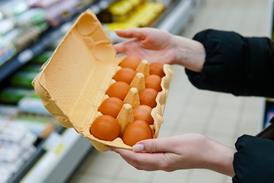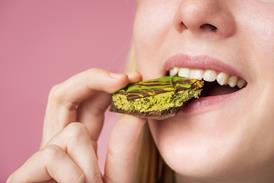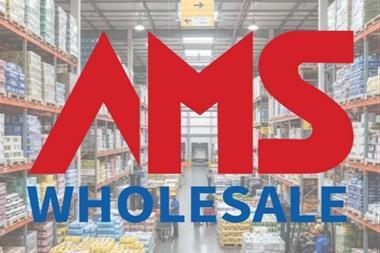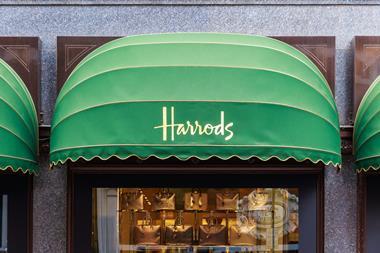Shoppers who are prepared to let their wallets hurt more than their hearts provide a lucrative opportunity for retailers, says Helen Lewis
Signs of affection can be nice little earners, especially when fond-hearted shoppers can be tempted to spend rather more than might have been wise on their beloved.
Those standard boxes of chocolates and flowers are being joined by more extravagant ways to say “I love you”. And hand in hand with this is a flurry of impulse purchases of smaller presents.
Recognising the spur-of-the-moment factor is crucial if supermarkets want to cash in on tenderness expressed with the wallet.
The so-called add-on purchase can be maximised if grocery retailers are clever about where they position and flag up those special little somethings with the rather bigger price tags.
Stores must also have an eye to the sassy marketing of the increasing number of speciality online gift sites, which came even further to the fore this past Christmas.
In food, manufacturers can bolster sales with line extensions presented in a gift format. A premium gift version of an existing product will continue to be an obvious and trusted profit strategy.
But entirely new products can also capture more consumer cash, especially at the big occasions such as Valentine’s Day and so on.
Food, flowers and wine are also being joined by a heftier presence of non food presented as gifts, from toiletries and toys to electrical.
Mark Collins, trade marketing manager at First Drinks Brands, which owns the whisky brands Glenfiddich and Grant’s as well as Amarula and Disaronno, says it is helpful to the industry if it markets gifts in three categories: nice gesture (token low-risk impulse); the safe-bet (tried and tested main gift); and wow factor (premium, indulgent, long-term use).
The latter has growing pull, as the gift-giver just can’t resist the temptation to shine all the more brilliantly because more has been spent.
Gifts geared around special occasions will also encourage people to stick into the trolley a brand they don’t normally buy, and at a higher price than it normally costs.
Sales of premium and indulgent seasonal novelties grew 11.7% last year [TNS Fused Panel y/e June 19].
Gifts, however, are now an all-year-round affair being driven by suppliers and retailers. As a result, sales of impulse gifts are soaring - sales in the ‘giving special treat’ category grew 31% last year [ACNielsen MAT to September 24, 2005], aided by new product development.
The confectionery market has been the most successful in optimising the potential of impulse purchases.
Last year Bendicks created Gorgeous, a boxed assortment of five, individually wrapped, bite-size milk, dark, white and marbled chocolates, to target impulse gifting.
Boxed chocolates are predominately bought by women for women and purchase motivation extends beyond special occasions into informal gifting to say thank you or to cheer someone up.
Andy Morrison, Bendicks trade marketing manager, says: “The Gorgeous pack has feminine appeal to attract younger women.”
TNS says the female friend-to-friend gifting market is worth £2bn and, because chocolate only represents 9% of all purchases in this market, there is huge potential [TNS GiftTrak 2004].
Retailers are also waking up to better product placement to increase gifting sales.
Heidi Jackson, category manager for impulse at Musgrave Budgens Londis, says: “Placing products together in-store can significantly increase impulse purchases - many consumers will add on the box of chocolates if they are right next to the flowers.”
However, there is a general consensus that retailers could do more to maximise sales of flowers and other impulse gifts. Morrison says retailers should signpost
Signs of affection can be nice little earners, especially when fond-hearted shoppers can be tempted to spend rather more than might have been wise on their beloved.
Those standard boxes of chocolates and flowers are being joined by more extravagant ways to say “I love you”. And hand in hand with this is a flurry of impulse purchases of smaller presents.
Recognising the spur-of-the-moment factor is crucial if supermarkets want to cash in on tenderness expressed with the wallet.
The so-called add-on purchase can be maximised if grocery retailers are clever about where they position and flag up those special little somethings with the rather bigger price tags.
Stores must also have an eye to the sassy marketing of the increasing number of speciality online gift sites, which came even further to the fore this past Christmas.
In food, manufacturers can bolster sales with line extensions presented in a gift format. A premium gift version of an existing product will continue to be an obvious and trusted profit strategy.
But entirely new products can also capture more consumer cash, especially at the big occasions such as Valentine’s Day and so on.
Food, flowers and wine are also being joined by a heftier presence of non food presented as gifts, from toiletries and toys to electrical.
Mark Collins, trade marketing manager at First Drinks Brands, which owns the whisky brands Glenfiddich and Grant’s as well as Amarula and Disaronno, says it is helpful to the industry if it markets gifts in three categories: nice gesture (token low-risk impulse); the safe-bet (tried and tested main gift); and wow factor (premium, indulgent, long-term use).
The latter has growing pull, as the gift-giver just can’t resist the temptation to shine all the more brilliantly because more has been spent.
Gifts geared around special occasions will also encourage people to stick into the trolley a brand they don’t normally buy, and at a higher price than it normally costs.
Sales of premium and indulgent seasonal novelties grew 11.7% last year [TNS Fused Panel y/e June 19].
Gifts, however, are now an all-year-round affair being driven by suppliers and retailers. As a result, sales of impulse gifts are soaring - sales in the ‘giving special treat’ category grew 31% last year [ACNielsen MAT to September 24, 2005], aided by new product development.
The confectionery market has been the most successful in optimising the potential of impulse purchases.
Last year Bendicks created Gorgeous, a boxed assortment of five, individually wrapped, bite-size milk, dark, white and marbled chocolates, to target impulse gifting.
Boxed chocolates are predominately bought by women for women and purchase motivation extends beyond special occasions into informal gifting to say thank you or to cheer someone up.
Andy Morrison, Bendicks trade marketing manager, says: “The Gorgeous pack has feminine appeal to attract younger women.”
TNS says the female friend-to-friend gifting market is worth £2bn and, because chocolate only represents 9% of all purchases in this market, there is huge potential [TNS GiftTrak 2004].
Retailers are also waking up to better product placement to increase gifting sales.
Heidi Jackson, category manager for impulse at Musgrave Budgens Londis, says: “Placing products together in-store can significantly increase impulse purchases - many consumers will add on the box of chocolates if they are right next to the flowers.”
However, there is a general consensus that retailers could do more to maximise sales of flowers and other impulse gifts. Morrison says retailers should signpost
















No comments yet